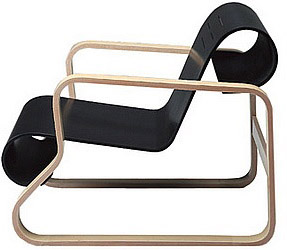The
Ageless Design of Alvar Aalto
by Bob Brooke
 Scandinavian
designers have beautified the world for the past three decades. One of
the best was Alvar Aalto of Finland, whose designs are as popular today
as when he first created them. Scandinavian
designers have beautified the world for the past three decades. One of
the best was Alvar Aalto of Finland, whose designs are as popular today
as when he first created them.
Were Alvar Aalto alive
today, his reaction to the popularity of his designs would probably be
mixed, a combination of satisfaction he'd feel at the continued
accessibility of his designs and his bemusement at the piety reserved
for these early modern classics.
One of Aalto's goals from
the outset was to devise furnishings that could be reproduced from
standardized materials, when he accessorized the interiors for public or
private buildings for which he'd been commissioned. While most of his
contemporaries were engaged in perfecting unique pieces for a particular
installation, few simultaneously planned an important piece of
architecture and assembly-line fittings.
In 1936, entered the
competition for the design of Finland's Pavilion for the Paris World's
Exhibition and for objects that might be exhibited in it .Among them was
a vase containing four dozen daffodils as if blown by the wind. Its
fluid shape is as eternal as a wave, suggesting various modifications
and adaptations.
While itís fitting to
commemorate Aalto's vase in this way, itís perhaps just as important
to pay homage to the thinking behind the piece. It embodies principles
of the best of Finnish design. The final meaning of the object is
determined by the user. Itís not imposed on the piece by the designer.
The vase echoes the formlessness of the materials itís meant to hold.
It looks as beautiful containing four dozen daffodils as it does with
just a handful of tulips leaning over one side, as if with the wind. Its
fluid shape is as eternal as a wave, suggesting a reason for its
continuous appeal.
In such a piece, art and
industrial design merge, blurring the distinction between use and
esthetic. This is just as the architect intended. There is a distinction
about its form,a universality about its appeal. While the reverence for
Alvar Aalto's vase is flattering, it is undeserved in one sense.
And though it has found a
place in the prestigious design collections of the museums of the world,
itís equally comfortable on the kitchen table of anyone's home.
Read
more about Alvar Aalto
< Back to Finland
Go to Swedish Sauna > |